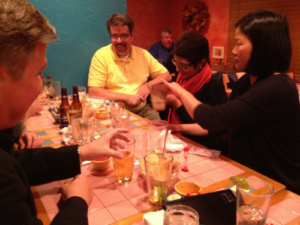Networking receptions are an industry standard. Yet one question has plagued every event planner at one time or another: “Where do I begin?” We are familiar with the essential considerations that affect an event like this, including food and beverage, decor, signage, audiovisual, giveaways, and budget. There are some other elements that, if overlooked, could make you wish you had a do-over. Here’s how to design a reception that encourages networking and leaves everyone feeling happy:
1. Determine the main objectives. Do you want to ensure your guests gain specific information? Is your goal to come out of this event with a certain number of new leads? The more detailed your plans are for this event, the more successful you will be in anticipating its needs and executing its outcome.
2. Consider your guest list. This can be the most challenging piece to ration, as many planners abide by the principle that the more, the merrier. Not only does “more” not necessarily equate to “merrier,” it often equates to an overwhelming amount of your dedicated budget being spent—dare I say, wasted—on food and beverage and any extras you may be offering.
3. Find a space. Once you have a guest list and a rough idea of how many guests you’ll expect, you can commit to a venue. Not just any platform—one that fits your group and satisfies the goals that you are seeking to accomplish. Go with a highly recommended medium by an industry professional you trust. In a perfect world, you’ll be able to travel to it and experience the place first-hand without introducing yourself as a planner outright. You want to know what the venue offers. After ensuring that the venue’s staff, food and beverage, and property are all up to par, it is essential to evaluate the layout of the space. A space that’s too open could limit mingling among your attendees. Cozier is usually better when planning for networking functions—bonus points for intimate (albeit still public) nooks and crannies like booths and balconies.
4. Pick the right F&B. You want your event to be stylish, and your food and beverage should be no exception. Be mindful of your guests’ dietary restrictions by offering a little of everything. Suppose you are limited to six hors d’oeuvres. In that case, I usually suggest selecting three hot and three cold, ensuring that at least two are vegan/vegetarian, one chicken, one beef, one pork, and one seafood option. Aside from offering a seafood option, I recommend removing ingredients that are prevalent allergens, like peanuts. With so many people suffering from severe allergic reactions to them—sometimes even just from breathing in the particles from peanuts—I don’t risk it. Further, don’t rely on catering staff to adequately describe what is being served. Ensure that legible signs indicate each item, both stationed and tray-passed.
Because you likely want to make a good impression, I recommend offering an open bar if you can swing it. Contrary to common banquet sales trickery, springing for a premium bar is usually unnecessary. To keep costs down, a signature cocktail is always an excellent addition, especially if its title encapsulates something memorable about your company, event, or audience, but make sure it’s relatively light on the liquor. You want your people mingling, not stumbling. To offset this further, selecting food items that are dense or starchy is a good idea. There will always be attendees who limit their carb intake, so you’ll want a tray of crudité and fruit, but you want them to gravitate toward the heavier items to anchor their adult beverage options.
5. Serve F&B correctly. Everyone has been to a reception with limited table space and carving stations or other heavy items that require utensils to eat them. Rookie mistake. If you serve your guests food that limits them to a dining round and a dinner plate, you are killing the networking element of your networking reception. Limit your seating areas to lounge seating for at most one-third of your anticipated guest count, and give your guests small bites they can pop in their mouths between introductions. Station highboy tables where you want the most traffic, and forget the stools. Don’t tempt them to park themselves in one spot for the duration of the event. Remember, this is a reception—not a meal.
6. Give them something to remember you by. When selecting giveaways and promotional items, be creative but practical. You want to give attendees something they will use regularly or create nostalgia around the memory of your event while keeping the item relatively small. If the thing is not small enough to fit in their carry-on with all of their other hot swag, chances are it won’t make it out of their hotel room. Add value by finding a way to pair the giveaway with pertinent information about your company or campaign.


Average Rating